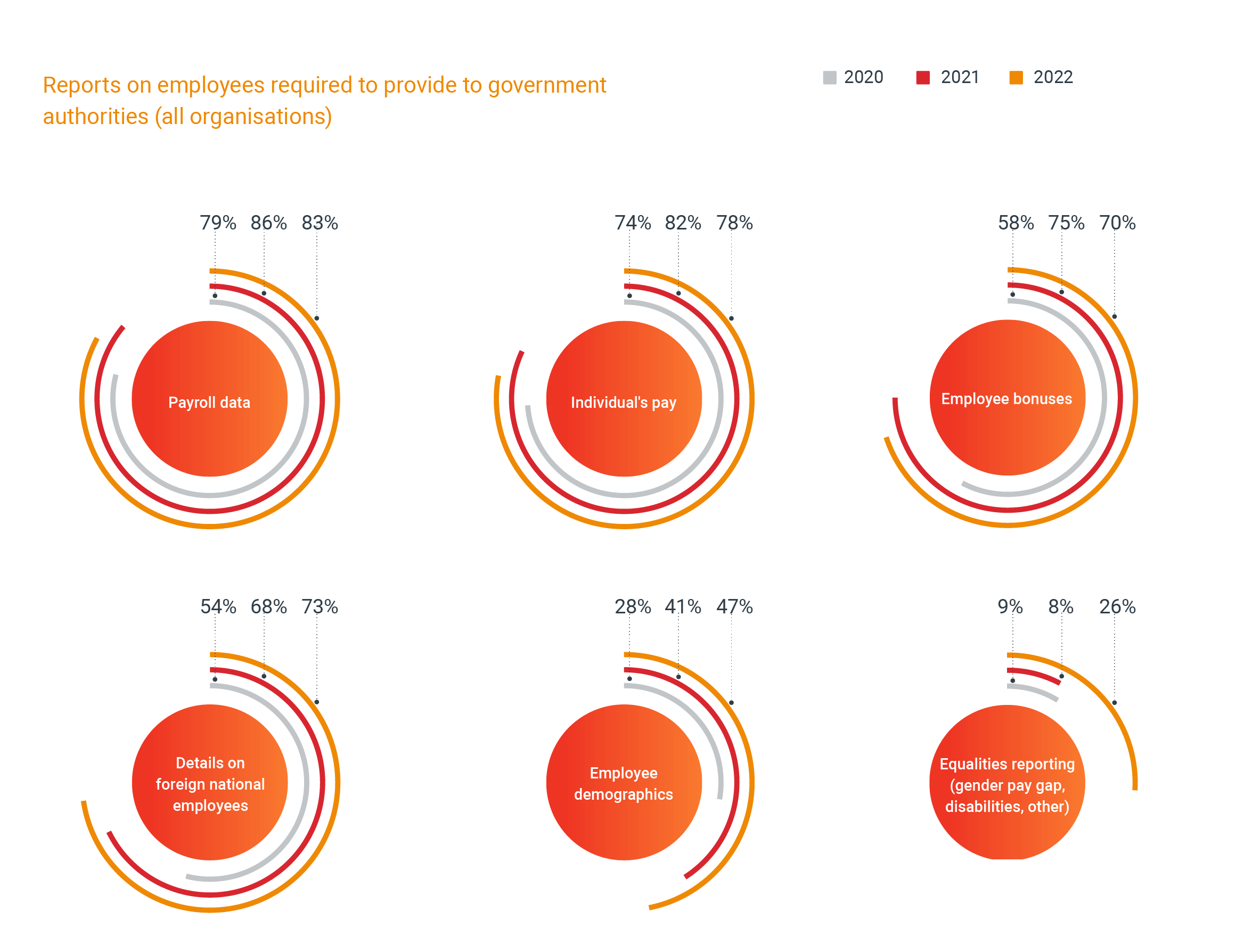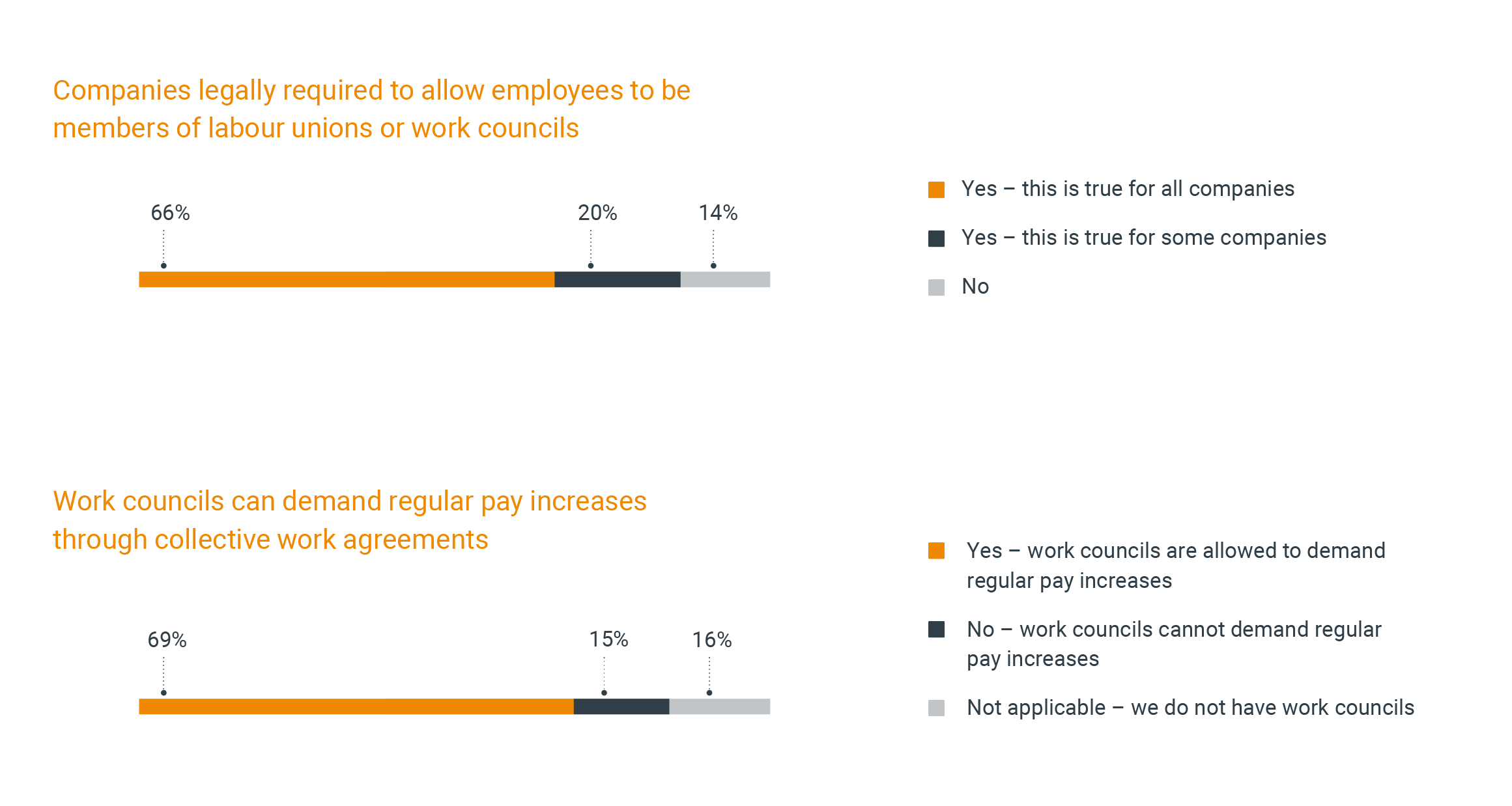GBCI 2022: Focus on payroll and human resources

TMF Group’s Global Business Complexity Index 2022 explores 292 different indicators relating to business complexity. Our analysis covers three core areas of business administration, and ultimately assigns an overall complexity score to each of the jurisdictions assessed.
This article focuses on the first of those three key areas of business, payroll and human resources, taking a closer look at some of the findings from this year’s Global Business Complexity Index (GBCI), along with commentary from our subject matter experts.
Benefits
Paid time off and minimum wage remain the top two legally mandated benefits globally, followed by paid maternity leave and paid sick days. Over the last three years, there has been a steady increase in the legal requirement for compassionate leave, childcare assistance, and housing/social care contributions, driven primarily by changing requirements in South American and EMEA jurisdictions. It’s therefore unsurprising that among the ten most complex jurisdictions for payroll and human resources, six are in the EMEA region and two are South American. Overall, there is a trend of companies being increasingly employee driven, which is perhaps linked to greater emphasis being placed on social responsibility.
The requirement for companies to submit reports on employees remains mandatory for most jurisdictions. As we’ve seen, reporting on equalities (eg gender pay gap or employees with disabilities) and employee demographics have increased compared to previous years. Details on foreign national employees are increasingly required to be submitted by all organisations, from 54% of jurisdictions in 2020, to 68% in 2021 and 73% in 2022.
Equalities reporting has seen the biggest jump year on year, with respondents in 26% of jurisdictions confirming that reports are required by their government authorities, versus 8% of jurisdictions in 2021. This increase is evident across all regions, with jurisdictions of note including Brazil, Argentina, Malaysia, Turkey, Slovakia, Vietnam, Slovenia, Guatemala, South Africa, Thailand, Chile and the Dominican Republic.

Additionally, this year’s research found that employee rights channelled through work councils and labour unions are common in jurisdictions, with 66% of all companies globally legally allowing employees to be members of labour unions or work councils. This is led by South America, where this is true for all companies in all jurisdictions. In 69% of jurisdictions globally, work councils are allowed to demand regular pay increases for employees, with this being led by EMEA (76%) and South America (70%).

Impacts of global mobility
The global mobility of the workforce will generate a need for more sophisticated payroll and HR services.
Covid-19 has had a significant impact on payroll and human resources, with many of those who were mandated to work from home continuing to work remotely at least some of the time. With remote working, employees have had the opportunity to move away from the city, or even country, of their workplace, accelerating the global mobility trend.
Before the pandemic, global mobility was primarily a company-driven initiative, where employees were moved to a certain location in order to do a specific job; the balance has now shifted towards employee-driven mobility. While this flexibility is broadly perceived as being beneficial for employees, for employers it can be a source of complexity as there may be additional HR and payroll obligations or considerations.
From a payroll perspective, you've got to consider residencies and taxes. Global mobility is increasingly a topic that companies need to address, and it isn't simple. They will need to make sure they've got in-house global mobility advisors, or that they're working with multiple vendors. They will need to keep track of visas as part of that service as well.
Our expert in Hong Kong pointed to the rise of global mobility, not just within the workforce, but also among supply chains:
We will likely see increased global mobility, as businesses seek to diversify both their markets and supply chains. Following the initial China-US trade disruption, and along with the ongoing impact from Covid-19, many companies will investigate and devise strategies to combat future disruption to their operations, and this will likely lead to engaging additional suppliers and vendors, as well as establishing manufacturing bases across a larger number of countries. International companies will need to grapple with the nuances of hiring, maintaining and in some instances laying off staff in a greater number of jurisdictions.
What does the future of payroll and human resources look like?
On the payroll side, digitalisation is playing a significant role, which has only been accelerated by the pandemic. For example, electronic payslips are becoming the norm in most regions, although some jurisdictions in South America are behind on this trend. Another, perhaps more novel, example is the introduction of chatbots to enable employees to get answers to HR queries, reducing the need to talk directly to HR professionals.
There tends to be a lot more electronic filing that goes on in APAC. Europe and North America are probably joint second. South America is an area that is wrought with complexity and a lot of manual processes. And it's the area where you still have to produce physical, hard copy payslips for employees as well.
Although digitalisation can simplify processes, such as accessing information, organisations are now increasingly leveraging data with payroll providers and demanding more information than ever before. Examples of this data include equalities reporting (eg gender pay gap, disabilities). Although reporting this information is often non-statutory, some jurisdictions are encouraging the disclosure of pay differences of board-level employees and the lowest-paid employees, providing an additional reporting burden for those in charge of payroll.
There's going to be more statutory reporting, people want more information and more data. I think any organisation these days - whether you're in business, in healthcare, a teacher - people value data more, so the demand for data and analytics will be greater each year.
With increased digitalisation in payroll and the requirement for further data and analytics on employees, this leads to the question of what data and information can we provide? The traditional payslip, while necessary for employees to see their level of pay and taxes, is a legal requirement for companies’ reporting. However, TMF Group experts predict that payslips could be used to provide more information to employees, such as predicted tax changes, commission rates if working in sales roles, or information related to equal opportunities.
In future, not only could there be an assessment of what data we provide to employees, but also a potential move towards demand payroll. It is commonplace that employees are paid monthly, but employees could be offered the opportunity of more flexibility in how they are paid by drawing down part of their salary. Flexible payroll is already quite prominent in the US, but it is unlikely to happen in the short term on a global scale.
Adele Ewing, Global Head of Payroll and Human Resources at TMF Group, adds:
Payroll technology has a key role to play in the consolidation of multi-country payroll operations, but it would be a mistake to diminish the importance of the human touch.
Providing businesses with access to payroll experts who speak the local language and understand the local business and regulatory environment makes a big difference when it comes to mitigating the risk of non-compliance in each country where they operate.
The risks associated with choosing the wrong payroll provider are numerous, and potentially very costly, so in that sense, it makes a difference for companies to consolidate their global payroll service provision.
The Global Business Complexity Index
The GBCI 2022 provides an authoritative overview of the complexity of establishing and operating businesses around the world. It explores factors driving the success or failure of international business, with a focus on operating in foreign markets, and outlines key themes emerging globally as well as local intricacies across 77 jurisdictions.
Explore the GBCI rankings, analysis and global trends to help you find your path to growth, amid the complexity of corporate compliance.
To download and read the report in full, visit the Global Business Complexity Hub today.
To find out more about the drivers of business complexity in the jurisdictions that matter to you, why not explore our Complexity Insights Dashboard?





